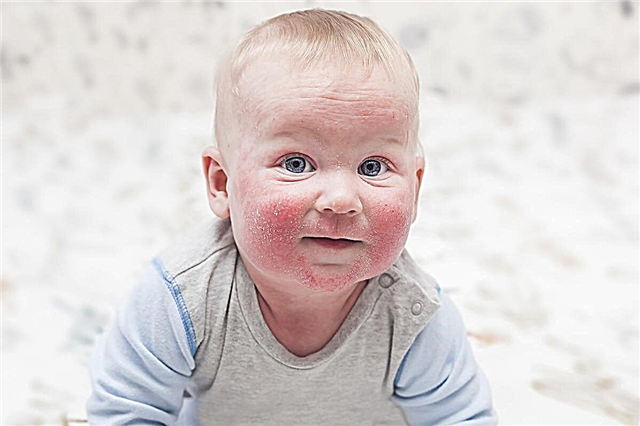Usually, a child's teeth climb at 4 months, the first signs of anxiety are observed from 3 months. Experts recognize a pronounced genetic relationship between the timing of the appearance of the incisors of the mother and the child. However, the reaction of the baby to teething is individual.

Symptoms of the appearance of the dentition in infants
The process of forming teeth in a child under one year old
Babies' teeth grow in pairs. The lower teeth in a child at 4 months come first, the upper row is filled within 2 months. Then you should expect the appearance of lateral lower and upper incisors, first molars, canines and second molars. By the age of three years, the set of the dentition has 20 units.
Bookmark rudiments
In the seventh week, temporary teeth are laid in the womb, at 17 weeks - the rudiments of permanent incisors. Sixteen permanent teeth are formed during the embryonic period. The rest of the follicles are observed after the baby is born: after 2 years - the 1st premolar, three years - the 2nd premolar and molar, five years - the 3rd molar.
The beginning of mineralization
The temporary teeth of the fetus are mineralized in the second half of intrauterine development. At the age of six months, with the introduction of complementary foods, permanent teeth 1, 3, 6 appear.
End of mineralization
The average time of mineralization of the first premolars is 2-2.5 years, of the second premolars and molars - 2.5-3.5 years, from the age of 8 the third molars mineralize.
Eruption
The timing of the eruption of deciduous teeth for the upper and lower rows is determined individually.
The upper teeth appear in the following order:
- central incisors - 8 ... 12 months;
- lateral incisors - 9 ... 13 months;
- canines - 16 ... 22 months;
- first molars - 13 ... 19 months;
- second molars - 25 ... 33 months.
Lower teeth:
- second molars - 3 ... 31 months;
- first molars - 17 ... 31 months;
- canines - 17 ... 23 months;
- lateral incisors - 10 ... 16 months;
- central incisors - 6 ... 10 months.
Attention! Dr. Komarovsky recommends setting up a calendar to celebrate the appearance of new teeth. With a dental chart, it is convenient to monitor compliance with standards, it is easier to visit a pediatrician or dentist.

The procedure for replenishing the dentition
Signs of teething in babies
The pain, accompanied by swelling of the gums, causes discomfort, changes in the baby's behavior. Signs of teething in a baby 4 months old appear 3-5 days before the incisor comes out, disappear as the gums break.
Unreasonable worry
Along with hyperemia and swelling of the gums, there are common signs of teeth in infants at 4 months: anxiety, irritability, moodiness. They are nonspecific and are found in various infectious or inflammatory pathologies.
Swollen gums
A couple of days before the appearance of teeth, the gums swell and turn red, the surface becomes loose, bumpy, in rare cases, hematomas appear.
Biting
When teething, newborns feel an irresistible urge to scratch sore gums. Kids begin to bite on various objects, their fists. A teether with a corrugated surface made of hypoallergenic materials will help to alleviate the condition.
Grabbing the ears
Pain in the gums through the common pathways of the nervous system spreads to the ears and cheeks. At the first symptoms of teething in infants for 4 months, children hold their ears, rub their cheeks and chin.
Intermittently eats
Trying to fill the mouth, relieving a little aching and itching pain, the baby gives the impression of being constantly hungry. Resorption increases the discomfort, forcing you to abandon breastfeeding or a bottle that was previously required. A toddler eating solid food temporarily loses interest in the new diet.
Falls asleep for a long time
Crying, restless night sleep, and mild fever can also help you know when to expect new teeth.
Constantly pulls pens in his mouth
The child constantly gives attention to painful processes in the gum area, pulls his hands into his mouth, bites hard objects, and seeks to reduce unpleasant painful sensations in the gums.

The child bites his own hands
Symptoms of teething in a baby at 4 months
Depending on the individual characteristics of the organism, the signs of incisors appear to a greater or lesser extent.
Profuse salivation
The symptom appears 1-2 months before the appearance of the dental crown itself. Increased salivation is a protective response to itching and irritation of the gums. Also, babies cannot automatically swallow saliva. The accumulation of fluid in the throat of a lying baby causes a reflex coughing, the syndrome disappears in an upright position.
Sensitive and itchy gums
Mechanical irritation of the sensitive nerves of the gums informs about the preparation of teeth for teething.
Temperature rise
A short-term (1-2 days before the formation of the edge of the dental crown) increase in body temperature to 39 degrees occurs against the background of local inflammation of the soft tissues of the gums. The blood is saturated with biologically active elements that enhance heat generation.
Diarrhea
Malnutrition, copious swallowing of saliva, increased intestinal motility in response to inflammation in the oral cavity provoke a thinning of the stool. The violation manifests itself 2-3 days before the appearance of the visible crown of the tooth.
Refusal to eat
During a period of anxiety, every baby has a weak appetite, this is natural.
Rash
Irritation, rash in the mouth, chin and neck area are typical reactions of the skin to constant moisture that appears with profuse salivation.
Cry
Whims, tears, jet lag are normal child's reactions to itching, pain and inflammation of the gums.
Rules to be followed by parents
It is important for parents to know several important aspects required to comply with teething in children:
- It is necessary to visit the dentist periodically when new teeth should erupt to form a correct bite.
- Teethers purchased for gums should be of medium hardness, exclude in the composition of non-food dyes, the likelihood of tearing off a piece and swallowing.
- To avoid caries, teeth should be wiped clean with cleansing wipes or silicone finger brushes at four months. Doctors later recommend choosing toothpastes and brushes carefully, taking into account the age and sensitivity of the child's gums. It is advisable to brush the teeth of the baby twice / day (in the morning and in the evening after eating).

Using a teether
Important! With the introduction of complementary foods (cereals, vegetable, fruit and meat purees), many parents are in a hurry to find out the recommended amount of calcium and vitamins that strengthen teeth and enamel.
How to help your baby with teething
In pharmacies, drugs are sold to relieve the symptoms of teeth in children. Using plastic rings or rubberized toys can help reduce stress on the baby's nervous system by preventing wasting.
The fact that teeth began to cut is indicated by profuse salivation. A napkin or towel will help remove excess moisture. At the time of sleep, you should put a napkin under the baby's head to absorb the fluid that is released, this measure will eliminate the need to change the soiled bed daily.
If you need medical help, the best solution in the fourth month of life will be "Dentokind", the drug has anesthetic and anti-inflammatory effects, calms the nervous system, normalizes sleep.

Medicinal product recommended for teething
You need to understand that teething is not a disease, but a natural process. The attention and care of others, constant distraction from pain will ease the baby's condition.



